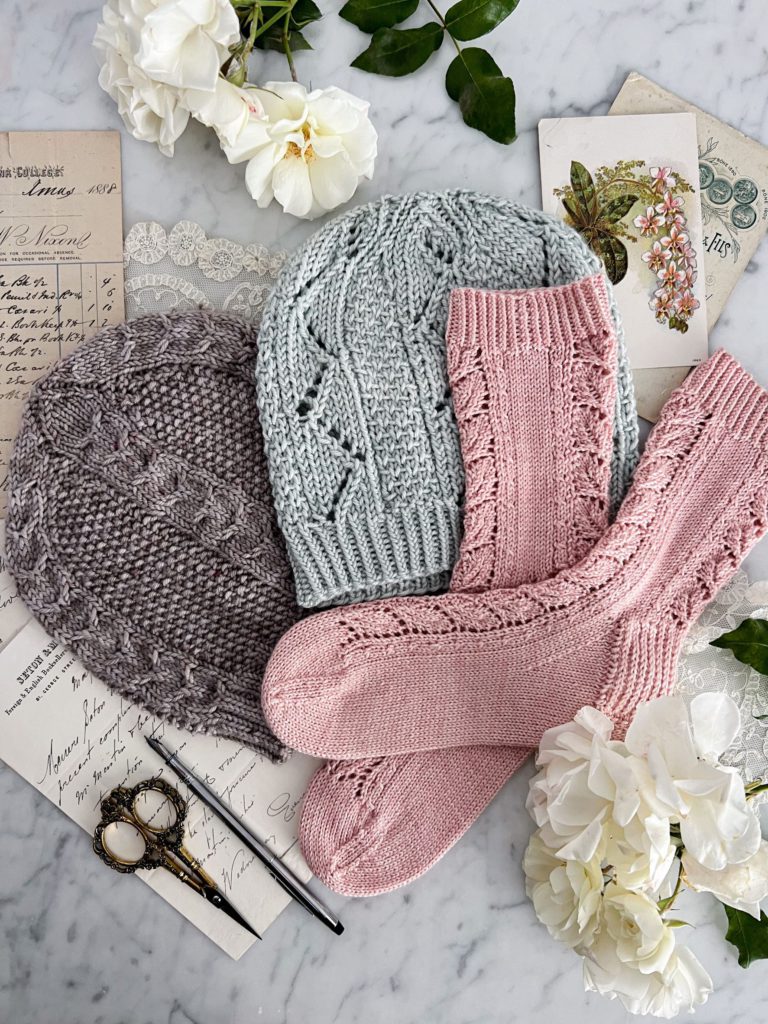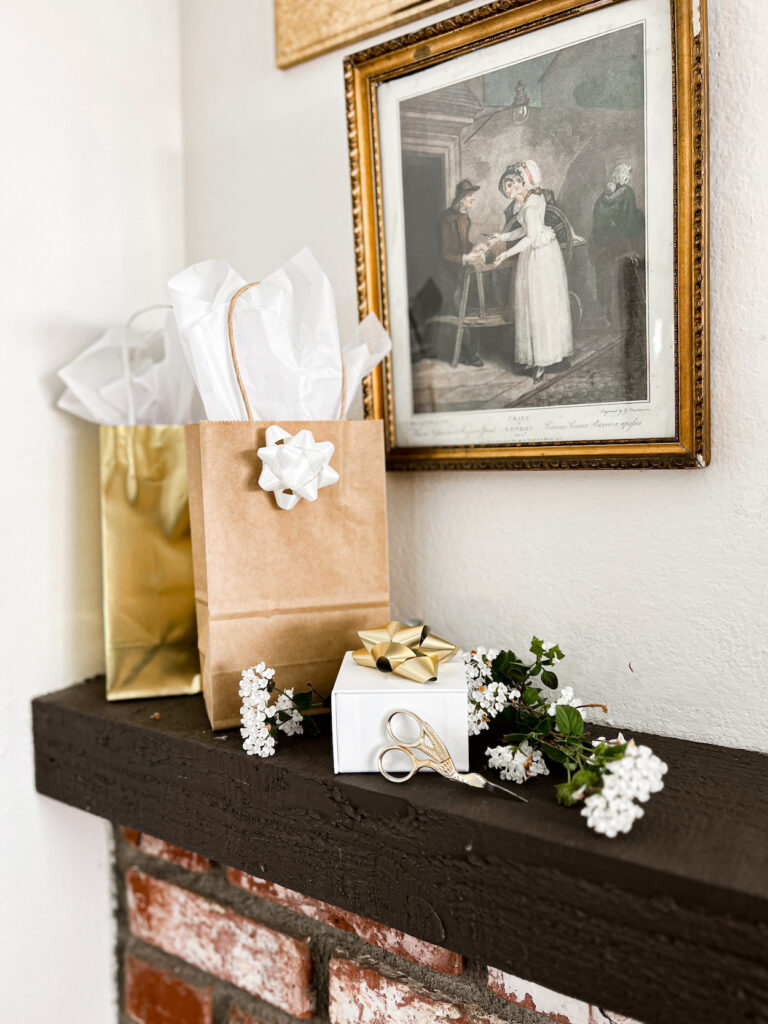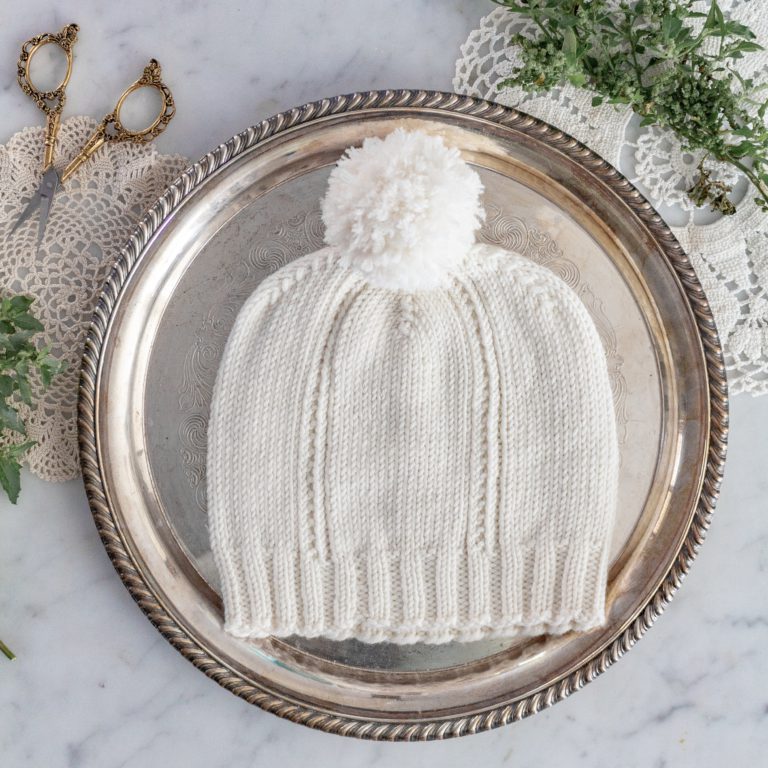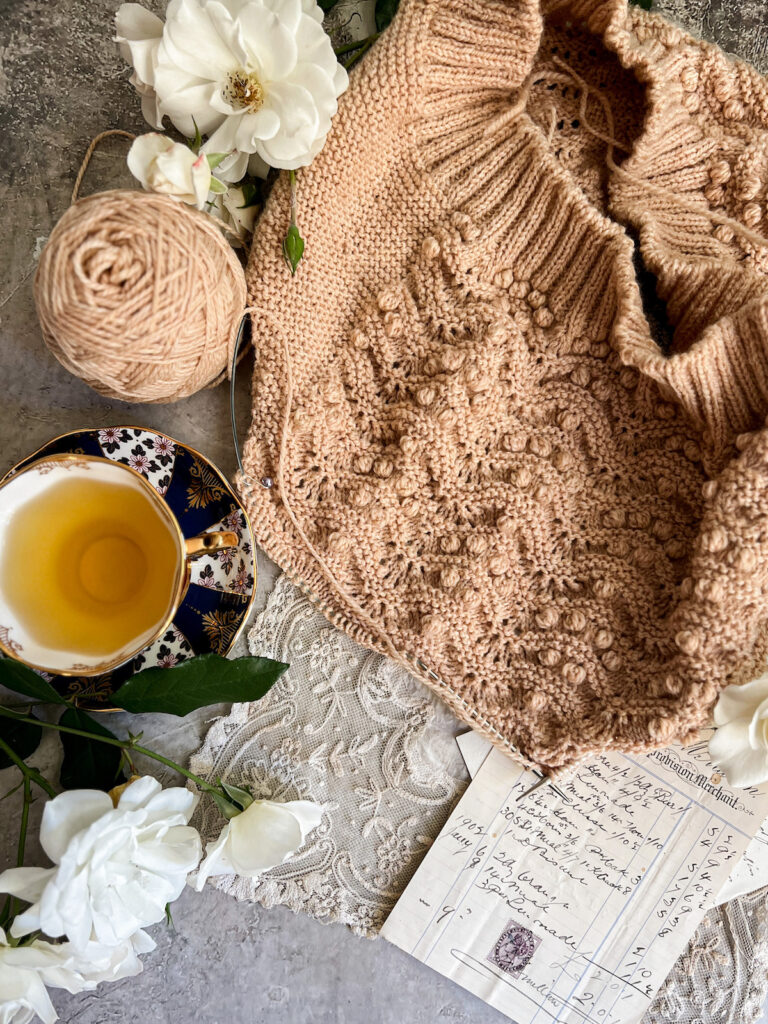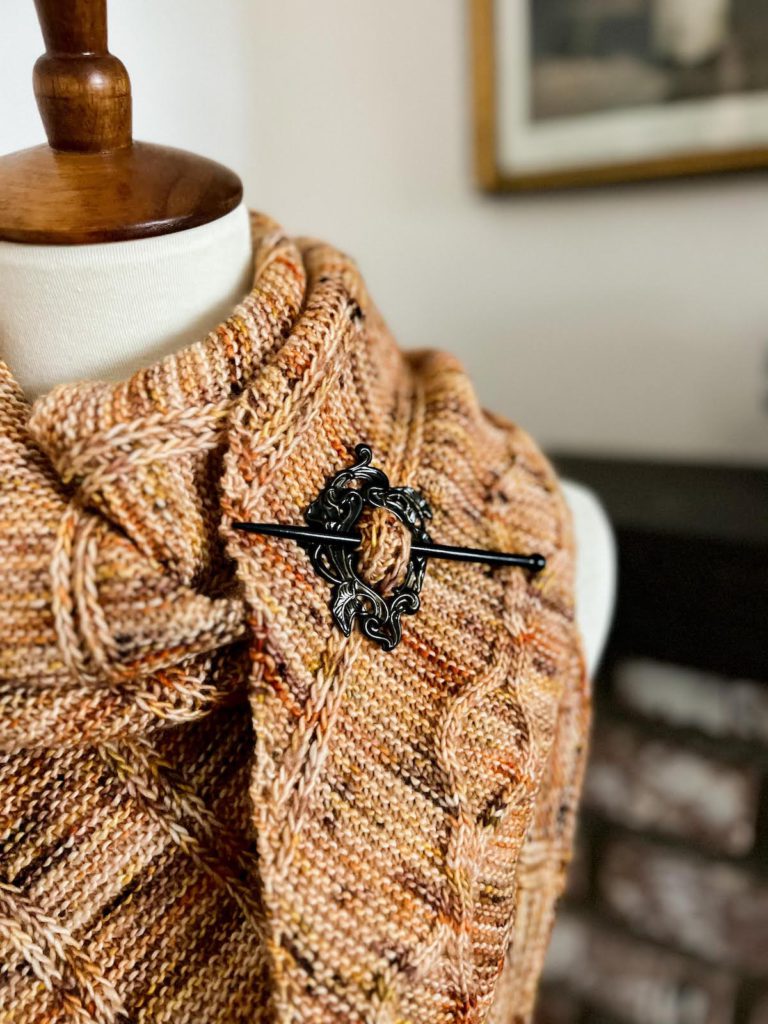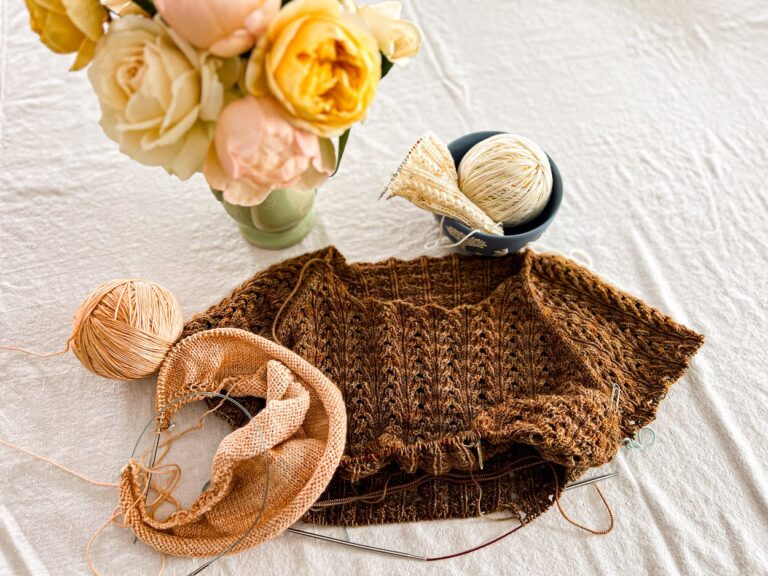Over the years, I’ve struggled to describe my aesthetic as a knitter, designer, photographer, and person. There are often pastels, but not always. I use a lot of teacups and old books. My knits feature tons of lace and bobbles and delicate texture, but all of it is part of my day-to-day life and therefore has to be sturdy enough for actual use.
And then, a while ago, something clicked: it’s everyday romanticism.
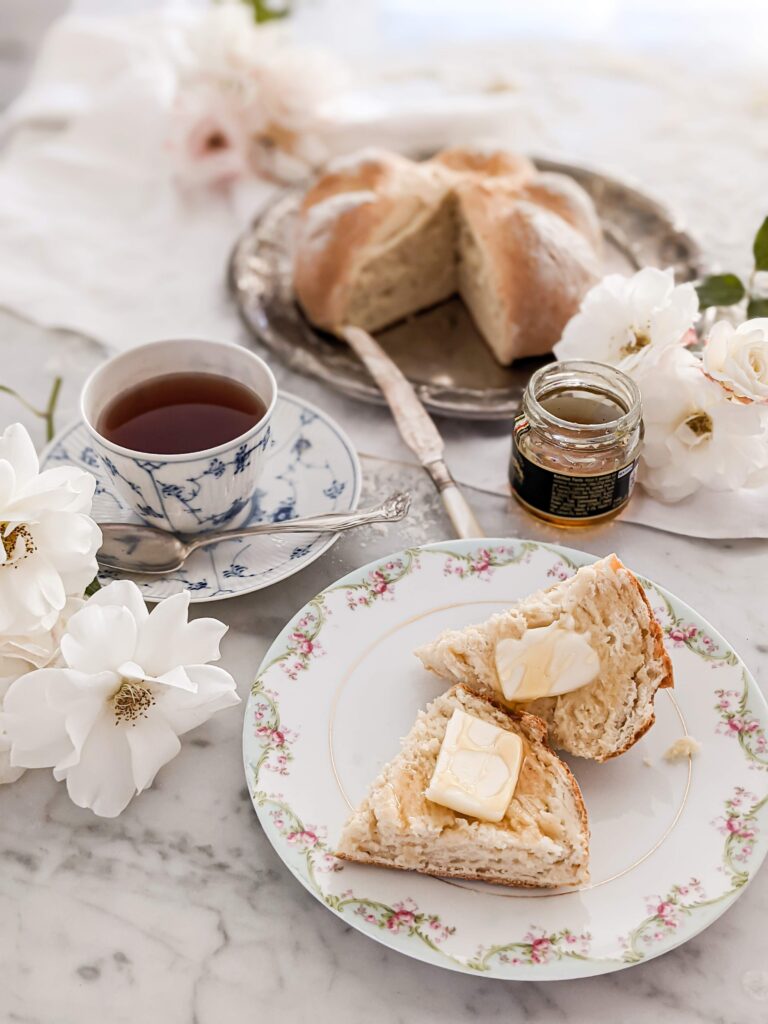
This phrase describes that sweet spot where the things I love all tend to live: the place where things are beautiful and soft but also useful. It’s a slightly fuzzy concept, though, so I thought I’d take some time to explain it a little more and talk about how to incorporate it into your own life.
What is everyday romanticism?
When I was younger, I used to think that my love of beautiful things made me seem weak or lesser. I was a lawyer. I figured my clients and opposing counsel expected me to seem tough and no-nonsense. As a result, I tried to push away that softer side of myself, wore all black to work, and kept mum about my love for costume dramas and 19th-century novels.
But that didn’t serve me well. I felt smothered, constrained, and worst of all, inauthentic.
So part of my journey toward embracing everyday romanticism involved embracing that need within myself to have beauty and softness in my life. It doesn’t have to permeate every aspect of life, but where it’s possible to add something pretty, I try to take advantage of that.
Now, when I think about the concept of everyday romanticism, I think of it as including three prongs. The first, and most important, is honoring your own need for beauty. The second is embracing the beautiful in the everyday, that is, recognizing that the small moments of life have their own charm, too. The third is finding ways to intentionally incorporate more beauty into your life.
A quick note: when I talk about everyday romanticism, I mean romanticism with a small “r.” This isn’t necessarily the untamed, individualistic Romanticism of Coleridge and Wordsworth (though their ideas have certainly influenced how I think about the world). In this case, I mean “romanticism” more in the modern common usage, where we use it to mean an aesthetic that incorporates softness and prettiness.
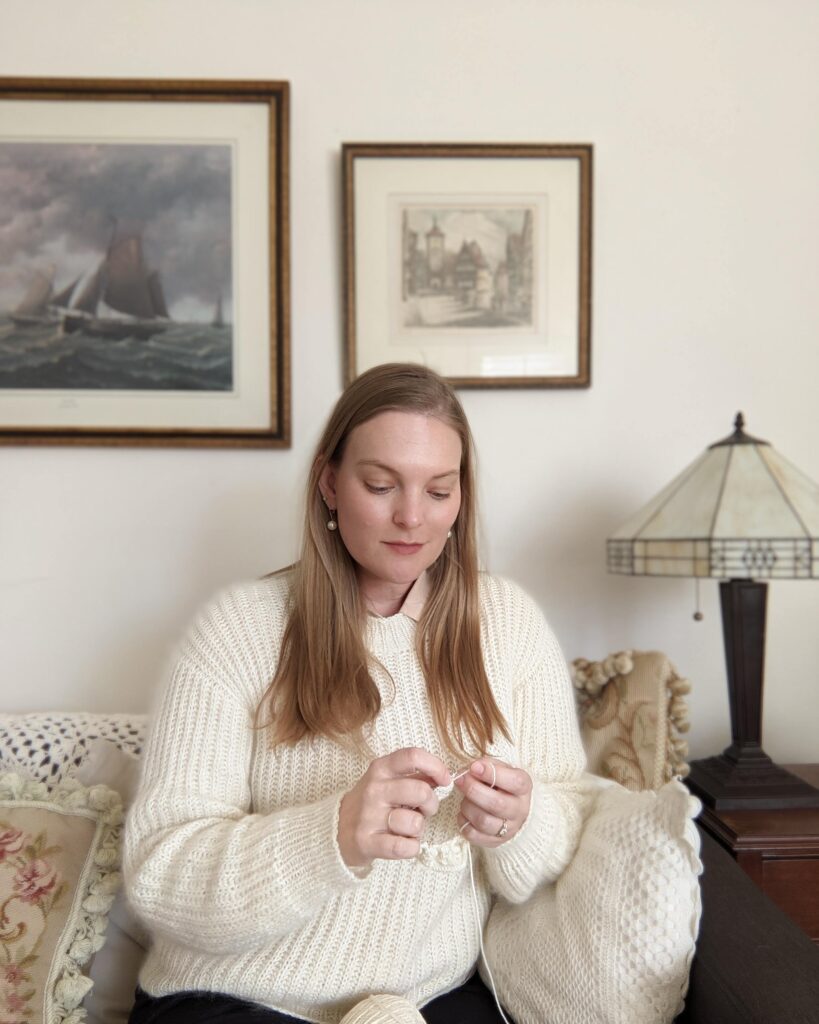
To embrace everyday romanticism, find the balance between beauty and purpose
When incorporating everyday romanticism into my life, I think it’s important to strike a balance and not go overboard. William Morris, the famed Arts and Crafts textile designer, wrote, “’Have nothing in your houses that you do not know to be beautiful or believe to be useful.”
My favorite place is the intersection between those two ideas, the items that are both beautiful and useful. Useful items don’t have to be ugly just because they get used every day, and beautiful things don’t have to be purposeless just because they’re beautiful.
One way I incorporate a little beauty into my everyday life is to look for beautiful versions of the things I’m going to use anyway. For example: a while ago, I needed to buy some new measuring spoons. I knew I could get a set of plastic measuring spoons or a set of metal spoons with swooping, curlicued handles. I knew I’d be using these spoons a lot, so I bought the pretty ones. Now they bring a little joy to my life on a regular basis.
But practicality has a role to play, too. There’s no sense in buying a beautiful thing that’s meant to be useful if you don’t actually use it. Here’s an example of what I mean.
I bought a gorgeous, horsehair broom with a wooden handle. Now, admittedly, I was influenced by photos of pretty cottages, but I thought it would be nice to have a broom designed to be gentle on my floors, and I liked its aesthetics.
Know what? I hate the dang thing.
It’s heavy and weirdly shaped, and I don’t like the feel of the handle, and the horsehair bristles just collect dust bunnies. I prefer the plain black nylon broom I got at Lowe’s.
So yes, beautiful things are nice, but if they’re not also fit for purpose, you’re just going to end up with clutter that frustrates you.
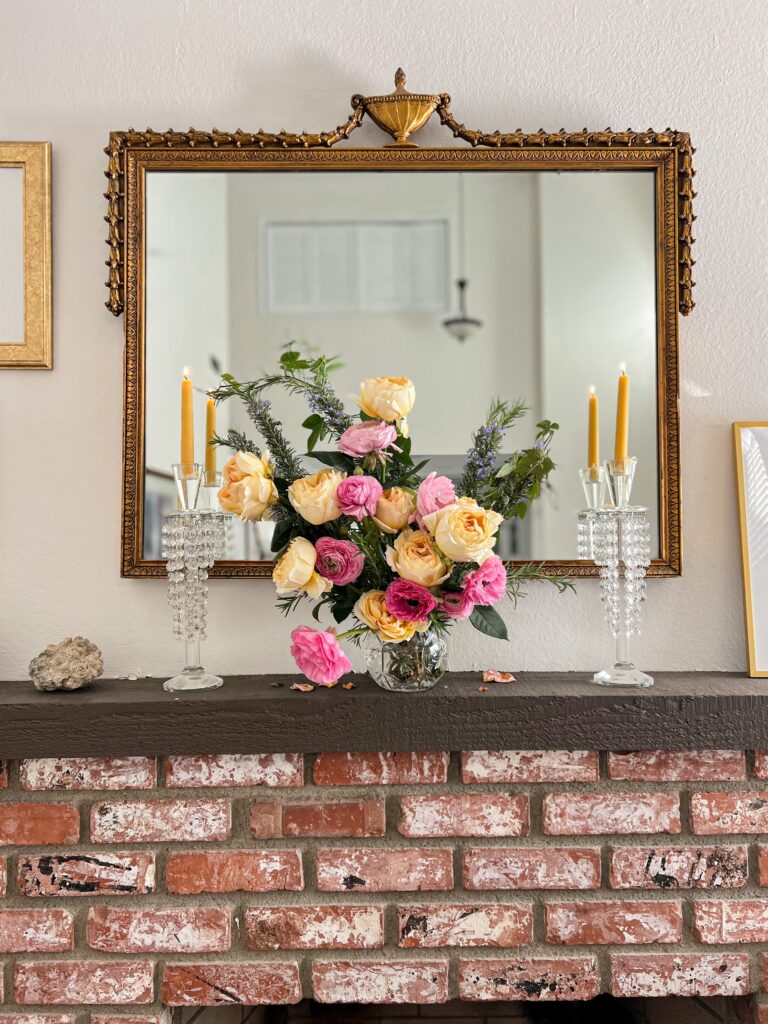
I also make sure to live by an important motto: if I don’t put holes in my knits, the moths will, so I might as well enjoy the process. In other words, use the good things now. Don’t save them for a special occasion because you’re worried about damaging them. They’ll get damaged one way or another because that’s just how life goes, so you might as well use them and appreciate them.
Each person’s version of everyday romanticism will look different
One of the things I love most about everyday romanticism is how it will look different in different lives. The form will depend on what the person loves, what their lifestyle needs might be, and how they move through the world. The one common thread is that each person will make room in their life for things that are beautiful and that speak to them.
Here are some of my favorite Instagram accounts that all have an everyday romanticism aspect to them. Check out how each one expresses this concept in different ways:
- Ultra soft romanticism: For the softest pinks and ruffles that still feel livable and not staged, be sure to check out Bridget Park (@deercircus). Bridget curates tiny wooden animals, painted candlesticks, and floaty dresses from local thrift shops and boutiques.
- Classic romanticism: Paula Sutton (@hillhousevintage) uses classics like brass candlesticks, tufted furniture, and layered wall art in her home, all of which lend a softness and intentionality to the space. There’s a lightness in her home that is really bolstered by a good splash of chintz here and there.
- Dark romanticism: If you need a little moodiness in your beauty, check out Elle (@leydi_milagros_). She still uses lots of flowers and antique textiles, but they’re made rich and deep using darker walls, statuary, and treasures from nature.
- Masculine romanticism: James Coviello (@james_coviello) shows that everyday romanticism isn’t only for women and people who are femme. With his love of faded flowers, chipped paint, and muted 19th-century glassware, he’s incorporated a flood of useful, beautiful things into his home.
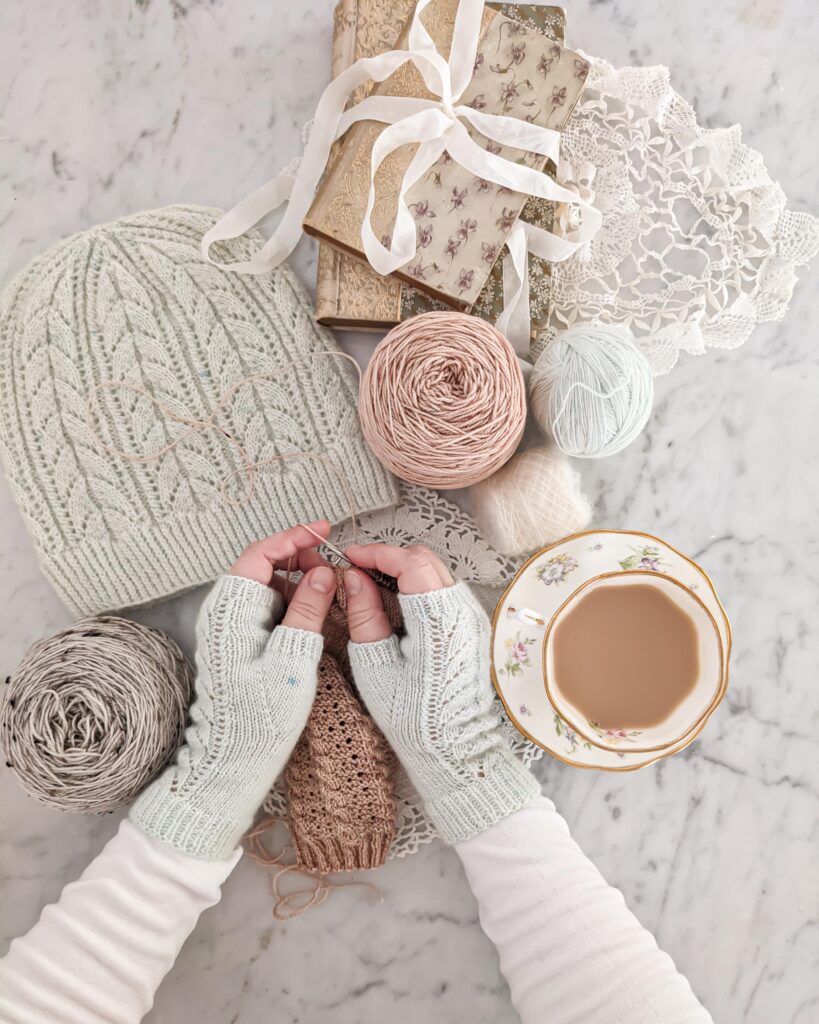
How to incorporate everyday romanticism into your own life
To bring your own dose of everyday romanticism into your world, it helps first to start with what you think is beautiful. Do you like soft pastels? Neutrals? Dark, moody colors? Is there a period in history or a place in the world that you feel a deep connection to? Are there themes in literature, music, or philosophy that resonate deep down in the core of your self? Take note of those. I like jotting lists and random ideas in Google Keep (I lose scraps of paper too easily).
Next, look for opportunities to incorporate beauty in your life. When I need to replace something in my home that is worn out or broken, I think about whether that’s a chance to replace it with something more beautiful. Note that this doesn’t mean throw out all your old stuff and start over again. It just means to wait for the opportunities to arise.
Think, too, about your budget. Now, I want to be very, very clear here: everyday romanticism is for everybody. You do not need to spend hundreds or thousands of dollars on antiques to make your space feel beautiful. I like to collect vintage linens (lace trimmed napkins, $1 a set) and old books at thrift shops. One of my favorite teacup and saucer sets was a $3 TJ Maxx find. It doesn’t matter whether your budget is high or low. It just matters that you know what your budget is, so that you can work within it.
Once you’ve established that budget, you can think about where to source the things you love. I like old things, so thrift stores, Etsy, eBay, and Facebook Marketplace are invaluable resources for me. Do you like handmade pottery, or delicately woven baskets, or natural curiosities? Whatever it is that makes you happy, make a little list of where you can find that stuff. Check those places regularly. Keep a log of what you’re looking for, when there might be sales, etc.
As you go through this process, work on making peace with imperfection. You’re not going to be able to transform your entire life overnight (and honestly, I’m not sure that’s even a desirable outcome). There will be items in your home that you know you want to replace, but the opportunity hasn’t arisen or you haven’t found the right replacement yet. That’s okay. We spent five years with a mattress on box springs because it took me that long to find a bedframe I liked at a price we could afford, but I still put antique French linen shams on the pillows. Things don’t have to be perfect for you to inject a little beauty where you can.
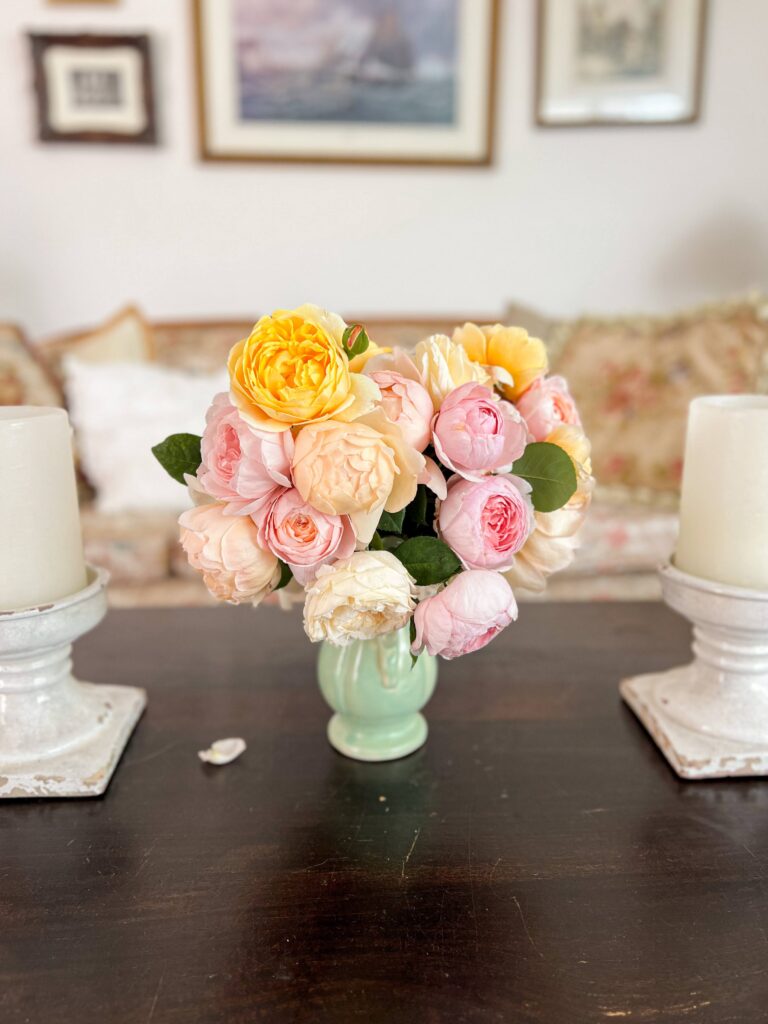
And finally, don’t rush it. Like a good capsule wardrobe, bringing romanticism into your life takes time. It’s a process of curation and sifting, of letting go of old things as they become worn out or broken beyond repair, of replacing those old things with beautiful ones as you find them. I’ve been working on my little collection of things that make me happy since I was a small girl. Give yourself time, and enjoy the journey.
Because the journey is a place to find beauty, too.
(A version of this post previously appeared on another website that has since closed)
Let’s stay connected!
Join my newsletter for 30% off all new releases, regular updates with helpful tips and tricks, first crack at registration for upcoming workshops, exclusive discounts, and more.
Join the A Bee In The Bonnet Facebook Group to participate in knitalongs and other fun community events
Come hang out with me on the A Bee In The Bonnet TikTok
Follow along on the A Bee In The Bonnet Instagram
Get inspired via the A Bee In The Bonnet Pinterest

